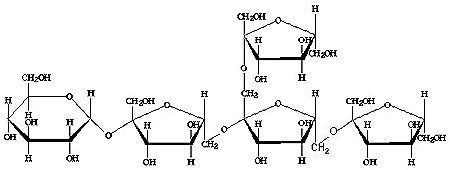 | ||
Non celiac gluten sensitivity and fructan celiac disease in the news
A fructan is a polymer of fructose molecules. Fructans with a short chain length are known as fructooligosaccharides. Fructans occur in foods such as agave, artichokes, asparagus, leeks, garlic, onions (including spring onions), yacón, jícama, and wheat.
Contents
- Non celiac gluten sensitivity and fructan celiac disease in the news
- Gluten versus fructans
- Types
- Functions
- References
Fructans also appear in grass, with dietary implications for horses and other grazing animals (Equidae).
Gluten versus fructans
Types
Fructans are built up of fructose residues, normally with a sucrose unit (i.e. a glucose-fructose disaccharide) at what would otherwise be the reducing terminus. The linkage position of the fructose residues determine the type of the fructan. Linkage normally occurs at one of the two primary hydroxyls (OH-1 or OH-6), and there are two basic types of simple fructan:
A third type of fructans, the graminan-type, contains both β-2,1-linkages and β-2,6-linkages.
More complex fructans are formed on a 6G-kestotriose backbone where elongations occur on both sides of the molecule. Again two types are discerned:
Functions
Fructans are important storage polysaccharides in the stems of many species of grasses and confer a degree of freezing tolerance. A notable exception is rice, which is unable to synthesise fructans.
